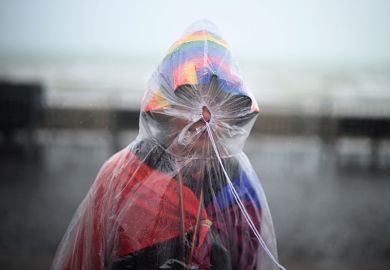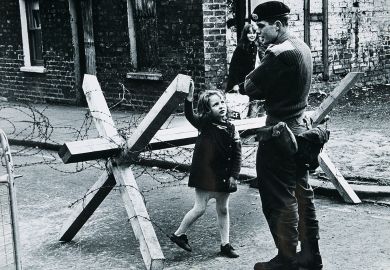Among the neglected subjects of the history of the Third Reich is the fate of the great works of art belonging to the Nazis or acquired by them after 1933. In this absorbing study, a model of archival research, Lynn H. Nicholas redresses this balance.
The starting point of her narrative is an auction by the Nazis of works of art considered to be degenerate. Held in Switzerland only two months before the outbreak of war, this auction saw prized modern works from several leading German museums, including a Van Gogh Self-Portrait, Matisse's Bathers with a Turtle and Picasso's Absinthe Drinker, go under the hammer, to the financial benefit of the Third Reich.
From the first political triumphs of Nazism, many established artists were prevented from exhibiting or selling work that displeased the custodians of the new ideology. Some artists were forbidden even to buy art supplies. "The smell of turpentine in the air or a container of wet brushes was grounds for arrest," Nicholas writes. Paul Klee and Otto Dix were among those removed from their posts as teachers and forced to give up their studios. When the museum director in Mannheim was caught hiding controversial works in the cellars of his museum, one of those paintings, a Chagall, was paraded around the city on a wagon as an object of derision.
In all this Hitler took the lead, telling an audience in 1937, after thousands of modern works had been removed from museums: "We will, from now on, lead an unrelenting war of purification, an unrelenting war of extermination, against the last elements which have displaced our Art." Three days later an exhibition of "Degenerate Art" mocked the works of abstract painters, pacifists and "the endless supply of Jewish trash that no words can adequately describe". Comments Nicholas: "Many art lovers came to see their favourites for the last time."
There then began a bizarre development, with Goebbels writing in his diary how he hoped to "make some money from this garbage" and Goering, seeking to build a private art collection for his own pleasure, taking some of the most valuable of these "degenerate" paintings, including a Cezanne and two Van Goghs, and selling them abroad, using the proceeds to buy for himself the Old Masters and tapestries he coveted. Hitler's own more modest collection was paid for by the royalties from Mein Kampf, and a surcharge on postage stamps bearing his portrait.
The ideology that could regard works of art as degenerate and offer them for sale, as at Lucerne, in order to make money out of them, could also denounce and destroy them. Five weeks before the Swiss auction in which 126 works of degenerate art had been put on the world market (and thus effectively saved for posterity), more than a thousand paintings and sculptures, and nearly 4,000 drawings, watercolours and graphics, were burned in a "practice exercise" in the courtyard of the headquarters of the Berlin Fire Department.
The coming of war brought a different opportunity for the Nazi chiefs: the lure of loot. Goering was foremost in this. Nicholas documents what he acquired and how, and the fate of his collection as the Third Reich collapsed. One of his favourite and most vaunted treasures, Christ and the Woman Taken in Adultery, by Vermeer, turned out to be a fake, painted on the eve of war. The annexation of Austria yielded confiscated works of art on a massive scale. "The signature of the despoiled person is always obtained," the American Consul-General reported to Washington, "even if the person in question has to be sent to Dachau in order to break down his resistance." Thousands of paintings were expropriated from Jewish homes, the expropriations being "legalised" by laws passed over the next few years. The annexation of Prague in 1939 exposed the museums and libraries of yet another capital to seizure: Breugel's Hay Harvest was among the treasures of Prague sent to Berlin, as were the Bohemian crown jewels. Even as Poland was being conquered its treasures were being sent to Germany, including the Veit Stoss altar from Cracow. The new ruler of Poland, Hans Frank, took what he could for himself: a German art expert later rebuked him for hanging Leonardo's Lady with the Ermine above his radiator.
Every page of this book, and the illustrations, is a tribute to the persistent delving by Nicholas into a murky world of greed and theft. She has made particularly impressive inroads into the events of the final months of the war as both looted and German national treasures were sent for safety to the mines and tunnels of southern Germany, there to be discovered by the Americans. As well as the drama of discovery, and the appalling complexities thrown up by the sheer scale of the paintings and other works of art that were recovered, she makes clear the dark side of the story. Among those, for example, who helped Goering acquire whatever paintings he wished was Hermann Bunjes, a former student of sculpture at the Louvre who became head of the German Institute in occupied Paris.
On being found by the Americans, Bunjes spoke enthusiastically of how he had been at Harvard before the war and would now like to work for the Americans. He also asked for a safe conduct to Paris for himself and his family to continue his research on 12th-century French sculpture on the Ile de France. His own outpourings revealed that he had been in the SS. Following a further interrogation, he shot himself, his wife and his child. Another unpleasant reminder of the dark side is a photograph of Eisenhower in one of the mines where a large haul of paintings had just been recovered. The general is grimfaced; that very morning he had been taken to the site of the first concentration camp to be reached his forces, and had seen the bodies of more than 30,000 former slave labourers and Jews who had been shot by their guards before they had fled from the oncoming armies.
In the immediate aftermath of the arrival of the Americans at the mine galleries and other more hastily prepared hiding places, some of the vast array of treasures that were recovered were looted by the victorious soldiers. Himmler's prized German medieval Saxon collection from Quedlinburg was traced, as late as 1990, to a small town in Texas. Some artefacts have never been found, including Bellini's Madonna and Child, sent to safety from the Kaiser Friedrich Museum in Berlin. The story, comments Nicholas, is one "without an end". Lost works of art are still being sought throughout Europe: "Many were lost and some are still in hiding."
This is a story that reveals an aspect of Nazism often overlooked: the pretensions of its leaders to cultural as well as military superiority, their total lack of inhibitions with regard to the creation of a German artistic monopoly of style and ownership, and, even as their empire was collapsing, the primacy of greed.
Martin Gilbert is the author of Second World War and The Holocaust, the Jewish Tragedy.
The Rape of Europa: The Fate of Europe's Treasures in the Third Reich and the Second World War
Author - Lynn H. Nicholas
ISBN - 0 333 62652 4
Publisher - Macmillan
Price - £20.00
Pages - 498pp
Register to continue
Why register?
- Registration is free and only takes a moment
- Once registered, you can read 3 articles a month
- Sign up for our newsletter
Subscribe
Or subscribe for unlimited access to:
- Unlimited access to news, views, insights & reviews
- Digital editions
- Digital access to THE’s university and college rankings analysis
Already registered or a current subscriber? Login



